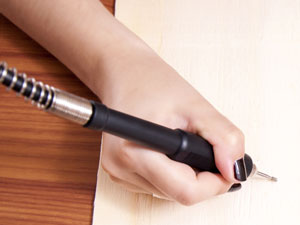Power Wood Carving Techniques
Power Carving • Carving Safety • Carving Techniques
Carving Tools • Carving Bits • Carving Accessories
 When it comes to using power wood carving tools, practice may not make perfect, but it will certainly improve the outcome.
Becoming familiar with the techniques of power wood cutting, and practicing frequently, will improve the quality of your
work.
When it comes to using power wood carving tools, practice may not make perfect, but it will certainly improve the outcome.
Becoming familiar with the techniques of power wood cutting, and practicing frequently, will improve the quality of your
work.
The first thing the power carver must learn is how to control the tool. Bits should always rotate toward the carver. The carver should anchor the thumb. Anchoring the thumb between the carving and the bit provides stability and control. For finer detail or texturing work that requires a smaller handpiece held like a pen, the carver should use the pinky as an anchor.
Once the thumb is anchored, the user should carve the wood by moving the handpiece toward the thumb. This increases the carver's view of the work, enabling the carver to better control where the wood is removed, as well as the amount of wood removed. If a left-hander is using the machine, the setting should be put in reverse to ensure the bit is rotating toward the carver.
Other common power carver techniques include:
- Wasting: Wasting occurs during the roughing out process, when large amounts of wood are removed.
- Roughing: Roughing is the process of bringing the carving into its rough shape.
- Shaping: Shaping is the next step after roughing. It brings the rough carving to a more recognizable shape.
- Relieving: Relieving raises the shape from the background. For example, if the carver is carving a bird, the wings would be relieved.
- Detailing: This stage requires the use of smaller tools with higher speeds, and brings out the finished details. For example, on a bird carving the beak would be given a mouth, and the bird's eyes would be given irises and lids.
- Texturing: Texturing is the final stage of wood carving. In this stage, details that make the carving more realistic are added. For example, a bird would be given feathers.